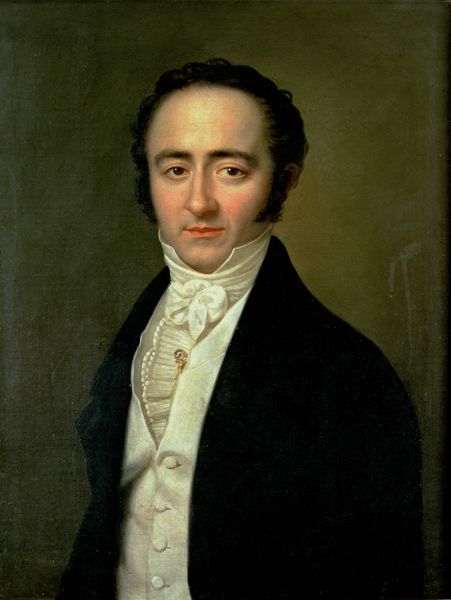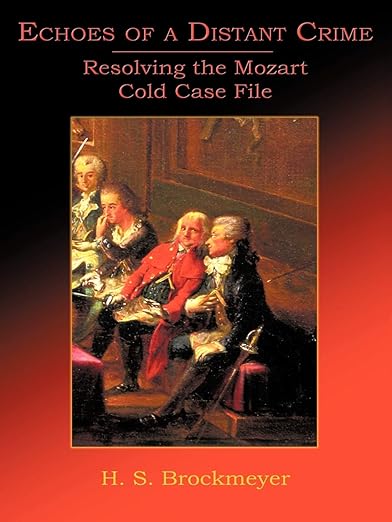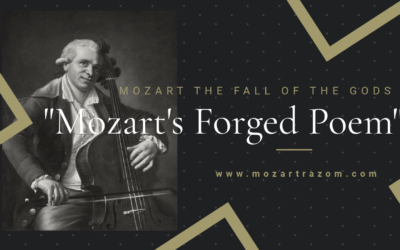Nissen's Missing Notebooks Resurface
Unveiling Hidden Plots
Article written by H. S. Brockmeyer
This second part delves deeper into Georg Nissen’s scheme to expose the truth about Mozart’s death, and the roles of Constanze Mozart and her sons in keeping it buried. As new details emerge, the mystery surrounding the famous composer’s final days grows even darker, with powerful forces potentially at play.
“Karl Mozart must have questioned himself: would it really be honouring his father, to expose such a starkly terrible crime?”
Echoes of a Distant Crime: Resolving the Mozart Cold Case File
After the death of the legendary composer Wolfgang Amadeus Mozart, his widow, Constanze, remarried in 1809 to Georg Nikolaus von Nissen, a Danish diplomat and passionate admirer of Mozart’s work. This union not only provided stability for Constanze and her children but also set in motion one of the most remarkable efforts to preserve Mozart’s legacy.
The story of Wolfgang Amadeus Mozart’s death has always been shrouded in mystery, with many accounts offering conflicting versions of events. In this second part of her investigative article Georg Nissen and the Missing Notebooks, H. S. Brockmeyer takes us further into the enigma, revealing even more about the clandestine efforts to conceal the truth behind Mozart’s demise.
Part I of Brockmeyer’s article exposed Georg Nissen’s plan to publicly disclose that Mozart had been murdered—a revelation that, if made, would have shaken European society to its core. Nissen, Mozart’s second biographer and the husband of Constanze Mozart, had gathered key witnesses, including the King of Denmark, and was ready to make a formal announcement. But his plans were thwarted, and the blame seems to rest squarely on Constanze herself, who, as Brockmeyer suggests, may have intercepted critical correspondence and blocked the exposure of the truth.
Now, in Part II, Brockmeyer uncovers even more stunning details. As Nissen lay on his deathbed in March 1826, awaiting an urgent letter from his stepson, Wolfgang Xaver Mozart, his final wish remained unfulfilled. With his death, the opportunity to reveal the conspiracy died too. Yet, according to the article, Constanze continued her efforts to keep the truth buried, going as far as manipulating her son to suppress his stepfather’s requests.

Portrait of Franz Xavier Wolfgang Mozart (1791-1844)
Now, in Part II, Brockmeyer uncovers even more stunning details. As Nissen lay on his deathbed in March 1826, awaiting an urgent letter from his stepson, Wolfgang Xaver Mozart, his final wish remained unfulfilled. With his death, the opportunity to reveal the conspiracy died too. Yet, according to the article, Constanze continued her efforts to keep the truth buried, going as far as manipulating her son to suppress his stepfather’s requests.
The article also takes a closer look at Sophie Haibl’s (Constanze’s sister) inconsistent accounts of the night Mozart died. While Sophie’s recollections to the Novello family in 1829 present a peaceful scene of Mozart’s final moments, her earlier letters to Nissen describe a much darker, more chaotic event. Brockmeyer raises questions about why Sophie felt the need to clarify who was in the room at the time of Mozart’s death. What was Sophie hiding, and how much did Constanze influence her version of the story?
The article goes further by exploring the mysterious Quartbücheln—two composition notebooks that Nissen mentioned in his will, which were passed on to Karl Mozart after his brother Wolfgang’s death in 1844. These notebooks, according to Brockmeyer, may contain the “essential excerpt” that Nissen planned to use to expose Mozart’s murder. However, Karl, who spent years in quiet contemplation, never acted on his stepfather’s wishes. Instead, he entrusted these crucial items to Alois Taux, director of the Mozarteum in Salzburg, along with Mozart’s beloved fortepiano.
Did Taux destroy the notebooks to prevent the world from learning the shocking truth, or did he hide them within the archives of the Mozarteum, waiting for the day they might be discovered? Brockmeyer paints a vivid picture of how these precious documents may still be lying in wait, concealed for generations in the hopes that, one day, they will resurface and bring justice to a long-buried crime.
Through Brockmeyer’s meticulous research and analysis, the article provides a compelling argument that a powerful group, possibly linked to the Freemasons, was behind Mozart’s murder. The cover-up, as described, could have involved threats against Constanze and Sophie, who remained silent for the rest of their lives, unable to reveal the truth for fear of retaliation.
As Brockmeyer concludes, we can only hope that the missing notebooks will one day be found, unlocking the mysteries of Mozart’s tragic end. Until then, we are left with the haunting possibility that the greatest conspiracy in music history remains hidden, waiting for its moment to be revealed.
To delve deeper into this fascinating story about Georg Nikolaus von Nissen and his connection to Mozart, you can download the full document from the link below.
Download the full document (pdf)
You May Also Like
#3 Leopold Mozart’s Literary Theft
Hidden within the Mozarteum’s archives lies a poem that has long been hailed as a tribute to the young Mozart children. But behind this innocent façade is a story of deception, literary theft, and one father’s ambition to rewrite history.
#4 The Golden Spur
While often portrayed as a prestigious award, the Golden Spur (Speron d’Oro) granted to Mozart in 1770 was far from a reflection of his musical genius. In this article, we delve into the true story behind this now-forgotten honour, its loss of value, and the role of Leopold Mozart’s ambitions in securing it.
Mozart Unmasked: The Untold Story of His Italian Years
Explore the lesser-known side of Wolfgang Amadé Mozart’s early years in Italy. ‘Mozart in Italy’ unveils the complexities, controversies, and hidden truths behind his formative experiences, guided by meticulous research and rare historical documents. Delve into a story that challenges the traditional narrative and offers a fresh perspective on one of history’s most enigmatic composers.
Another Example of Borrowed Genius
The myth of Mozart’s genius continues to collapse under the weight of his reliance on others’ ideas, with Leopold orchestrating his son’s supposed early brilliance.
A Genius or a Patchwork?
The genius of Mozart had yet to bloom, despite the anecdotes passed down to us. These concertos were not the work of a prodigy, but a collaborative effort between father and son, built on the music of others.
Myth, Reality, and the Hand of Martini
Mozart handed over Martini’s Antiphon, not his own, avoiding what could have been an embarrassing failure. The young prodigy had a lot to learn, and much of what followed was myth-making at its finest.







